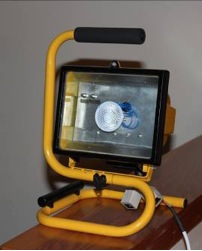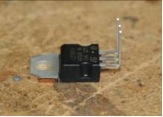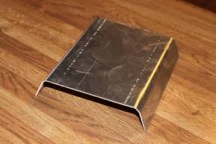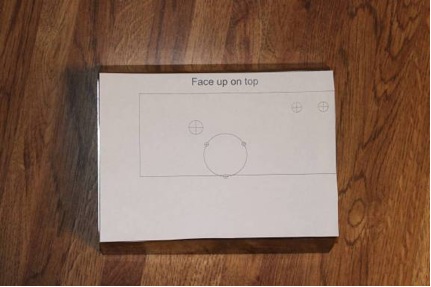Manual AetherII
Lynx Aether II Manual

Thank you for choosing to build the Lynx Aether II. I believe you will be happy with your choice.
WARNING! This Device has been design for personal use as a means of education and entertainment. As such it is not rated, tested, or approved for any use and I assume no responsibility in the use or operation of this equipment or for the accuracy of any information made on part of itself. This device has been design for my use and my use only. This is simply an explanation of how I built my own personal one for informational purposes. I make no warranties written or otherwise to it. It should be considered an experimental device with possible unknown characteristics.
Do not stare at a functional Aether Light as at worst it can hurt your eyes and at the least make you see spots for hours.
Please use static precautions in the handling of these parts. If you are not familiar in them please research on the internet prior to handling them. You can damage you parts with improper handling!
Contents
Preparing to Build
The next thing we want is to make sure you are up to speed on soldering and electrostatic protection of the components in your kit. If you are not an experienced printed circuit builder I recommend you visit the site: http://curiousinventor.com/guides/How_To_Solder And check out there extremely good video on soldering correctly. Even if you are an expert it is a good video to watch.
Another issue you must be aware of is that some electronic components can be damaged easily by electrostatic charges that can build up in you or your equipment. We have all been shocked by walking on carpet and grabbing a door knob before. This is electrostatic charge in action. It takes much less than this to hurt some of our parts. If you are unfamiliar with procedures to protect from this please use the internet to research it before opening your parts up. You can damage your parts if handled wrong!
You will need a few tools that do not come with your kit to build the Aether II. You will need a good soldering iron. I can not stress enough that a good soldering iron makes a big difference in these projects. The little 15w cheap irons are more apt to hurt your parts by taking too long to get the parts up to soldering temperature than a good iron which can bring it up to temp very fast. Remember it is more how long you keep the part hot than it is how hot you get it within reasonable soldering temperatures. A good soldering iron can be had for very reasonable amounts of money. You can purchase one for $30 to $60 dollars. Most anything that is called a soldering station where there is a temperature control separate from the iron itself will more than likely be fine but make sure it is rated for more than 15 watts. I myself use a cheap Weller like this one [1]
Another recommended Solder Station is the MPJA 302A is has a digital temperature readout
- http://www.mpja.com/prodinfo.asp?number=15141+TLMPJA Model 302A
It works fine and is very inexpensive. I even saw this model on sale at Sears. Radio shack has a very nice looking digital model on sale but be careful as it does not allow you to replace the tip. Tips are a part that wear out and need replacing from time to time. While we are on tips get some. I recommend you get the smaller chisel shape as this work very well for all around board building.
You need solder so buy some. I recommend the .032 size as the larger sizes tend to cause you to put too much solder on. How much? Go ahead and get a 1 lb spool as it\'s cheaper in large volume and you will go through it faster than you think. Make sure you are getting rosin core for electronics they make some solder for plumbing that has acid as the core this is a bad mistake to make.
You need some work area to work with good lighting. Do not attempt to solder circuit boards in poorly lighted areas. If you wear reading glasses go get them you will want them I promise you. I recommend a set of helping hands like this: http://www.radioshack.com/product/index.jsp?productId=2104639&cp=&parentPage=search
This manual was done to make it possible for the first builders to assemble their kits. It is not a great manual and it is my hope that as builders build using it they as has happened in the past will take pictures and update it to create a great manual for future users. I am very limited by time and as so can only do so much. I am sorry it is not a better manual but I believe by taking your time and looking the picture over well you will see it is an easy build and the manual is enough to get it built. Once done you will see it was an easy build. RJ
Step 1 - Prepare Case

Prepare your case by removing all of the inside parts to get it empty except for the case itself. Then flip it over and after cutting the male rj45 jacks off your pigtails, as close up to the ends as you can so you have as much cable left as possible, open the plastic box by removing the four screws on the cover and remove the cover without damaging the rubber gasket.
Remove the heavy power cable from the light and feed the pigtails and what ever wires you are using through the same holes. Make sure to slide the nut off the power cord and over your new cables first so you can screw it back on to seal it up.
Step 2 - Bend Voltage Regulators

Find all of the voltage regulators that have three or five legs. Find the one marked LD33V and set it aside we are not going to do anything with it in the step and it should be left alone.
Now you should have a 7812 & 7805 each with three legs and four LM2941\'s with five legs laying in front of you. Take each one and with the metal back laying down against your bench so the part numbers are facing up where you can read them you need to bend their legs using your needle nose and make them point straight up away from the bench.
If you look at the 7805 and 7812 you will see a small area next to the body of the chip that the pins get wider. Bend them right where they get smaller so most of the pin is pointing up. Then stay the same distance and do the same with the LM2941\'s
Then put them away for later.
Step 3 - Drill Template

Using the Template provided as the last page of this manual, lay the template on what will be the back of the heatsink. If you have the heatsink facing the correct way the heatsink will touch the bench only on the narrow edges of the ears of the heatsink and the rest of it will be raised off the bench as shown.

Tape the cutout template on the heatsink as shown.
Now there are three sizes of holes shown on the template.
The holes are marked by a crosshair where to drill.
The giant circle is where the led sits and has no crosshair.
Three small ones center around a large circle, Two Medium size holes at the top right and the large one.
Drill the three small ones with 3/32" bit. Drill the Two medium ones with a 1/4" bit Drill the large hole with a 3/8" bit
Step 4 - Solder small Parts
Now it is time to assemble the pcb. This is a fairly straight forward build. Each of the parts are marked clearly on the pcb. I recommend you start with the smallest parts and work up to the taller parts.
First install the fuse and solder it. It looks like the .1 uf capacitors but is longer and a darker green.
Now install the 8 small .1uf capacitors where marked and flip the pcb over and solder them in place. Next do the same for the 120 ohm resistor and the 4.7K resistor.
